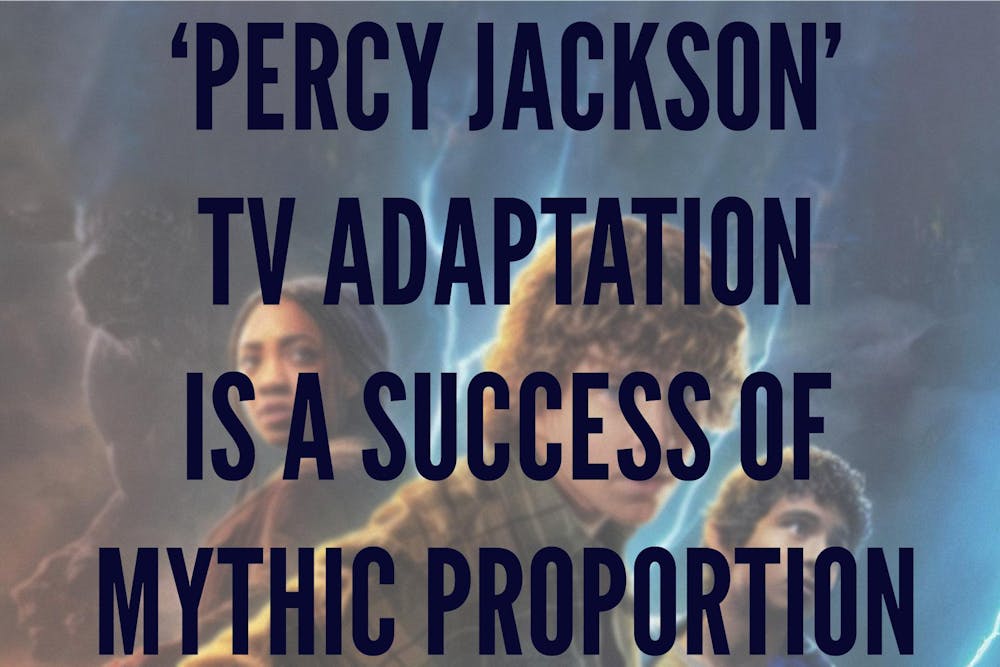The “Percy Jackson and the Olympians” Disney+ series was announced in May 2020, and ever since I have been patiently awaiting the TV adaptations of the books that bred my Greek mythology obsession. I mean, I’m a PLS major reading a ton of ancient greek texts for class; it’s safe to say I never got over it. I knew I would fall in love with the show no matter what (I’ll always be excited for any PJO content, good or bad), but I also found myself analyzing it as a TV show based on quality and writing as well while watching, already knowing the plot well. So how does the show live up to its expectations?
First off, the casting. Author Rick Riordan and the rest of the casting team found some gems to say the least because stars Walker Scobell, Leah Sava Jeffries and Aryan Simhadri have got to be some of the most talented children out there. Scobell, who was Ryan Reynolds’ mini-me from “The Adam Project,” was well known prior to this show, and his attitude was sure to make him the perfect Percy. His co-stars, Jeffries as Annabeth and Simhadri as Grover, two lesser known child actors, stepped up to the plate and gave it their all. Their energy perfectly matched Scobell’s when it came time for Annabeth, Grover and Percy to set off on their quest.
The content of the story required these kids to be extremely versatile, not only acting through emotional and stress-packed scenes, but also being physically trained for their fight scenes, especially for both Scobell and Charlie Bushnell, who plays Luke. Their hard work obviously pays off when watching their fight scene in the last episode. The quality of acting definitely shows that the creators knew the audience they were targeting: both new fans and older fans awaiting the adaptation.
Another aspect of the show that I really appreciated were the sets, especially the sets of the Underworld and Olympus. I think the designers really captured the stillness and eerie nature of the ancient Greek world well, such as in Hades’s empty palace. While the green-screen quality may not have been the best, I appreciated the attempts at making some cool visuals for Olympus and the Lotus Hotel and Casino as well. The design shows how important the inclusion of the author in the creative process is when making an adaptation, and Rick Riordan’s contributions certainly captured the energy of the books on-screen. It was evident that there was a divide between how young Percy, Annabeth and Grover are and how big the places they found themselves in were, both physically and metaphorically.
Overall, the most important thing that the show did right was capture that energy that had the “Percy Jackson” books on every Gen Z kid’s bookshelf growing up. The changing of the plot towards the end was something that I didn’t see coming, and I think that the fact that the narrative was still well resolved had every kind of audience member hooked. Once again, Uncle Rick kept everyone on their toes. You may be wondering why I haven’t once mentioned the movie adaptations, and that’s because, as Riordan himself said in a viral Threads post, we need to “normalize bad movie erasure.” I think that keeping this show in a constant conversation and comparing it with the movies takes away from the success and ability of the show to do right by Percy and his friends. After all, the 2010 Lotus scene will still be available to watch on Disney+; this kids’ show just didn’t need the implication of 12 year olds being drugged. I personally think that the show is worth the watch, not just for its entertainment value, but also for its message of rough family dynamics and representation of kids with unusually hard lives. If you haven’t yet given it a watch, perhaps be like me and buy a Disney+ subscription solely for this. I promise it is worth it.










